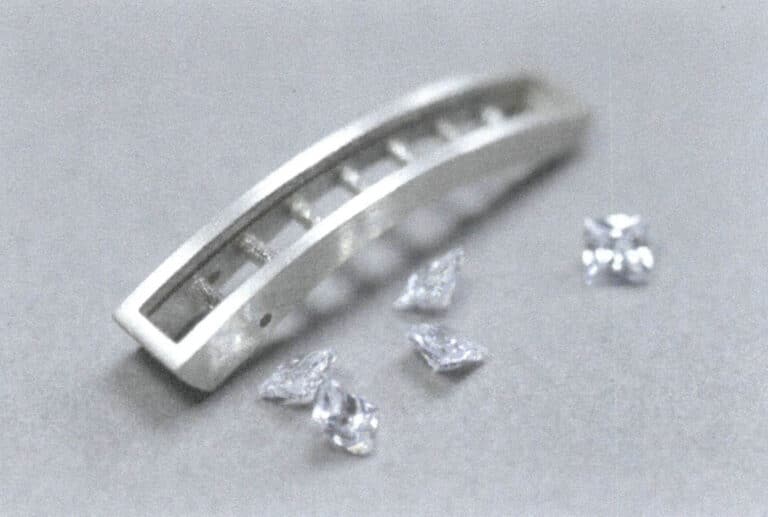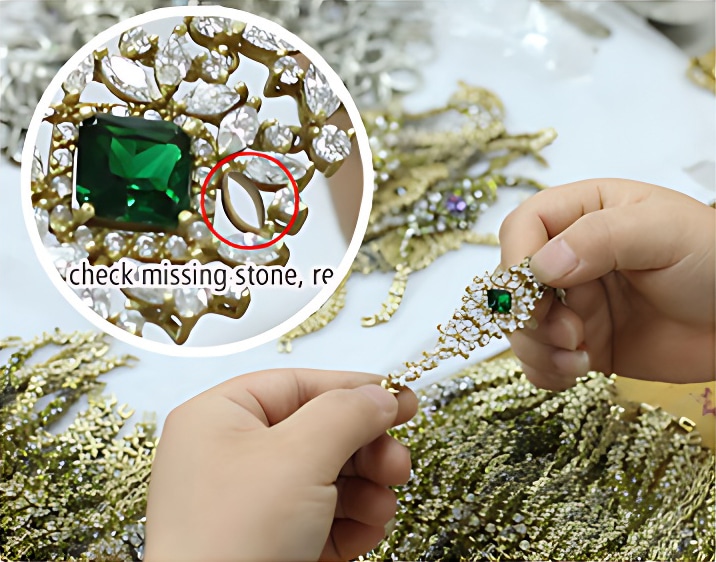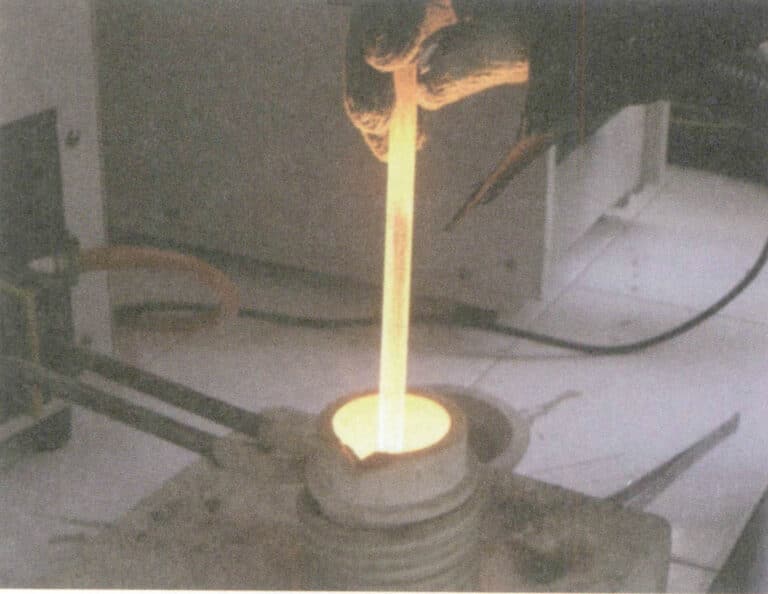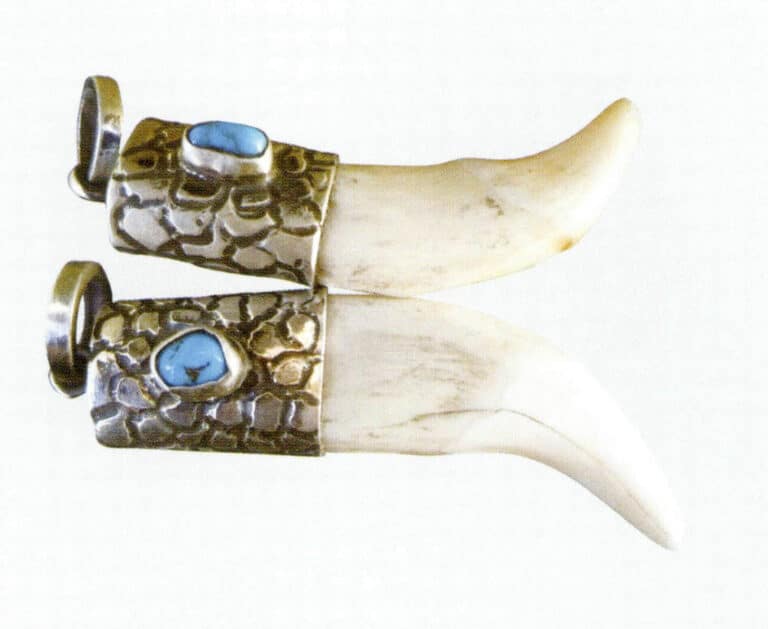What Makes Miao Silver , Tibetan Silver & Thai Silver Jewelry So Unique
Discover the Allure of Miao, Tibetan & Thai Silver Jewelry: Material, Styles, Craftsmanship & Culture
Εισαγωγή:
This article delves into the fascinating world of Miao, Tibetan, and Thai silver jewelry, exploring their unique characteristics, materials, categories, and production techniques. Miao silver jewelry is renowned for its intricate craftsmanship and cultural significance, with designs ranging from delicate hollow collars to elaborate silver crowns. Traditional Miao silver often includes materials like cupronickel and features symbolic patterns passed down through generations.
Tibetan accessories are deeply rooted in spiritual and cultural heritage. They are made from materials such as Tibetan silver, tricolor copper, cow bone, and precious stones like turquoise and Dzi beads. Each piece, from prayer bead-inspired necklaces to ornate amulets, carries a sense of mystery and religious symbolism.
Thai silver jewelry, known for its distinctive blackened finish, combines traditional craftsmanship with modern appeal. Using techniques like filigree and inlay work with gemstones like garnet and marcasite, Thai silver pieces offer a rugged yet elegant aesthetic.
Whether you are a jewelry store owner, designer, or an e-commerce seller looking to expand your collection, this article provides valuable insights into the rich cultural heritage and skilled craftsmanship behind these unique jewelry styles.
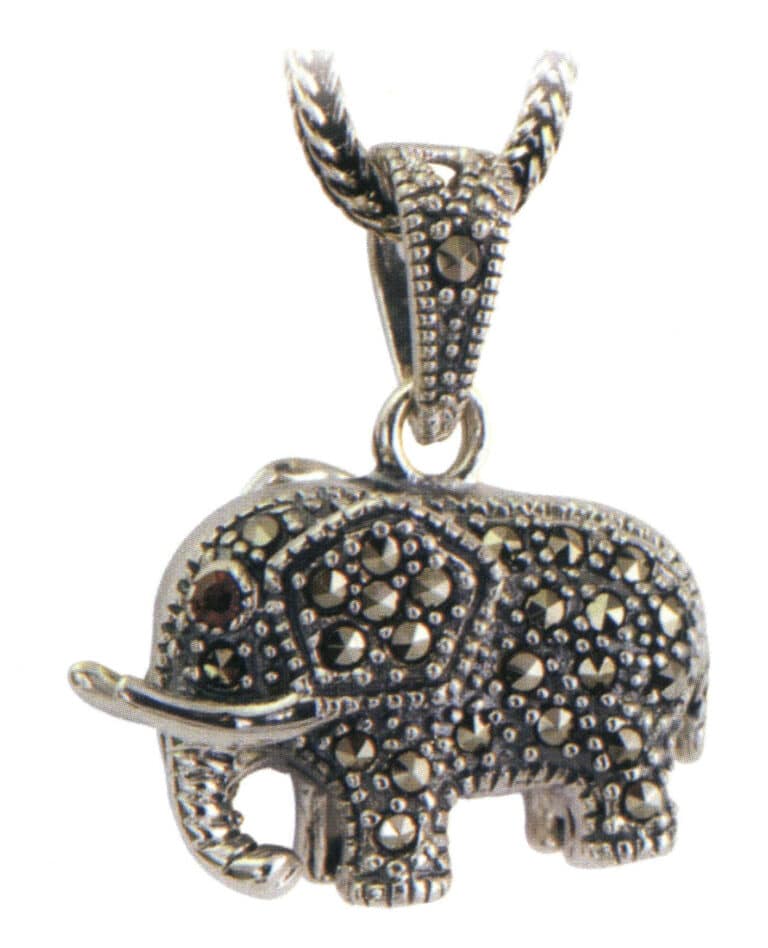
Miao silver jewelry
Πίνακας περιεχομένων
Section I Miao Silver Jewelry and Production Techniques
1. Introduction to Miao Silver Jewelry
“Miao silver” is a new word that has emerged in recent years, originally referring to “Miao ethnic silver ornaments.” For convenience, people abbreviated it to “Miao silver.” The Miao population is large and widely distributed, and they generally enjoy wearing silver products, both men and women, with young women being the most prominent. In the Ming Dynasty, Guo Zizhang’s “Qian Ji” Volume 59 and Zhai Jiusi’s “Wangli Wugong Lu” Volume 6 recorded that the Miao people in eastern and central Qian used “silver rings and silver circles to adorn their ears,” but the quantity was small. By the Qing Dynasty, the use of silver ornaments reached its peak, becoming widespread and abundant. For example, Miao women in eastern Qian wore silver flowers on their heads, silver rings in their ears, and silver circles around their necks, with “the more, the richer.” Miao women in western Hunan and northeastern Qian also wore “large rings in their ears and silver circles around their necks, ranging from one or two to over ten.” Silver ornaments in central Guizhou, Yunnan, and southern Sichuan were also common but in smaller quantities. After the founding of the People’s Republic, many Miao people still used silver ornaments, and the manufacturing process became more exquisite and delicate. The “large earrings” from the Qing Dynasty had been replaced in many areas by delicate and exquisite bead-style earrings, and the craftsmanship of necklaces and collars became very refined with the emergence of finely crafted silver crowns and silver clothing.
The silver ornaments of the Miao ethnic group are all made by male craftsmen of this ethnic group, with the highest craftsmanship found in southeastern Guizhou and western Hunan. The finished products are divided into two categories: coarse items, such as the buckle necklaces, solid collars, and solid bracelets from the Huangping, Lushan, and Taijiang areas of southeastern Guizhou, which generally do not require exquisite craftsmanship and use a large amount of silver, to display wealth. However, there are also more finely crafted items like hollow collars, hollow bracelets, and hollow diamond-patterned collars and bracelets, which, although more labor-intensive to make, use less silver. The fine items are very delicate, with famous examples including silver flowers from the banks of the Qingshui River and Wuyang River in southeastern Guizhou, waist chains, silver feathers, silver bubbles, silver sparrows, silver chains, silver crowns, silver Luohan, silver bells, silver chains from western Hunan and northeastern Guizhou, silver flowers, silver earrings, hairpins, silver bells, silver butterflies, silver medals, silver shawls, and silver crowns used for rituals. The production of these silver ornaments is extremely labor-intensive, with some requiring multiple processing steps. For example, to make silver chains, silver must be drawn into strands as fine as hair, and then dozens of these strands are woven into a hexagonal silver chain that presents a “human” character shape on each side. The silver crowns from southeastern Guizhou are even more of a pinnacle of silver ornament craftsmanship, with silver flowers, silver bells, silver sparrows, silver butterflies, silver bells, and silver sticks welded onto a small crown frame, weighing about thirty to forty taels, with dozens or even hundreds of pieces, each a finely crafted work that shines with the wisdom of the Miao people.
In the past, the productivity in the Miao region was backward, but the Miao people have always been hardworking, toiling from dawn to dusk, with the purpose of saving some “Luo Luo silver” to make nice silver jewelry and dress up my daughter beautifully. If I want to make a complete set of Miao silver jewelry, it would take a lifetime of savings. It is precisely because of the hard work of the Miao people that we have today a large number of exquisite Miao silver jewelry filled with the breath of life.
2. Miao Silver Materials
In the traditional sense, Miao silver material is not pure silver; it is a unique type of silver metal specific to the Miao ethnic group, with a more complex composition that includes silver, cupronickel, nickel, etc. The silver content generally varies from 20%~60%, mainly depending on the raw materials. If processed using two-jiao silver coins, the silver content is only 30%~40%; if processed using silver dollars, the silver content is 89.1%. Historically, a large amount of “Luo Luo silver” circulated in Guizhou, which people now call “round discs.” Many old Miao silver ornaments are also made from “luoluo silver,” with a silver content of around 95%. These silver ornaments also contain a small amount of gold (the gold content comes from the co-occurrence in silver mines).
Traditional Miao silver is often more expensive than 925 silver (925 S), mainly because Miao silver is crafted with exquisite workmanship, and its value is primarily reflected in its artistry. However, many unscrupulous merchants in the market are using the “Miao silver” banner to produce finished products made of cupronickel, then electroplating a layer of silver on the surface to impersonate Miao silver jewelry.
3. Miao Silver Jewelry Categories
Miao silver jewelry is mainly distributed in several major river basins, such as the Qingshui River basin in the central dialect area, the Bala River basin, the Paiyang River basin, the Douliu River basin, and the relatively affluent areas of the eastern dialect area, including the Yuan River basin and the Li River basin. In contrast, the Miao people in the western dialect area mostly live on steep mountains, with scarce water and limited arable land, and historically struggle to meet their basic needs, making silver jewelry a rare item. Each branch of the Miao ethnic group has its unique silver jewelry, with differences that can be significant or minor. When further categorized, silver jewelry varies by branch, and even within branches, there are differences due to regional isolation. This has led to the formation of a dazzling and diverse array of Miao silver jewelry.
The decorative parts of silver jewelry can be divided into headdresses, neck ornaments, chest and back ornaments, waist ornaments, hand ornaments, and foot ornaments. The main ornaments are further categorized into different types based on branches and sections.
3.1 Headdresses
There are silver crowns, silver hairpins, silver combs, silver scarves, silver earrings, silver children’s hats, etc. Headgear is an important accessory. Adorned with shimmering silver and surrounded by colorful ornaments, the girl’s face appears even more magnificent and elegant, leaving the strongest impression at first glance. The headgear is meticulously crafted by silversmiths, showcasing their exquisite skills.
(1) Silver crown. Its structure generally uses about 3 mm iron wire as a framework, and hundreds of silver flower clusters are wrapped around the iron wire frame for the cap top. The surrounding of the cap is wrapped with thin silver pieces decorated with diamond patterns, and the lower edge is adorned with dozens of silver pendants attached with silver chains, covering up to the eyebrows and above the ears. Silver crowns are divided into two main categories: with silver horns and without silver horns.
(2) Silver headscarf (also known as silver headband). It is often paired with a silver crown. Generally, it is a wide silver piece that can wrap around the head, featuring images of warriors on horseback, with the number of horses varying from 7~14. This is the core pattern of the headscarf. The upper and lower edges of the headscarf are adorned with various flowers, grass, fish, butterflies, birds, and small pendants. Some are also very simple: a piece of silver surrounded by a sun figure in the center and a fish pattern burled on both sides.
(3) Silver hairpins and silver combs. They are the most common in Miao headdresses, serving both to match formal attire and as practical items for securing hair in everyday wear. The designs of silver hairpins are particularly diverse, including straight and curved shapes, conical, flat, needle-like, round, hanging, and bouquet shapes, with patterns of flowers, birds, butterflies, fish, dragons, and various plants and animals, matching the patterns of the costumes of different branches. The silver hairpins accompanying formal attire create a brilliant three-dimensional effect. Some are multi-layered, with hanging silver flowers, while the silver hairpins for casual wear are simple and elegant. Silver combs are crescent-shaped or semi-circular, generally made of wooden combs wrapped in silver sheets, with various decorative patterns on the silver sheets.
(4) Silver earrings. They are essential jewelry for Miao women; some men also wear them. To wear earrings, girls from the Shidong area have to pierce their ears with a red silk thread using a needle when they are 1 year old. From ages 6 to about 13, they insert glutinous rice grass into their ear holes one by one, adding a few each year to gradually enlarge the ear holes, which can accommodate up to four or five dozen threads, allowing them to wear a pair of earrings weighing about four taels. The larger the ear holes, the wealthier the family, to the extent that the weight of the earrings tears some women’s ear holes. The shapes of the earrings include silkworms, leaves, wheels, cylinders, pendants, lanterns, silver hooks, etc. Women from Shidong and Gejia prefer to wear large cylindrical earrings that stretch their ears long; they believe that long ears are also a form of beauty. Shidong also has cicada-patterned earrings, one male and one female, with asymmetrical designs that are closer to nature. The silver lantern earrings from Huaxi are divided into three layers and are particularly exquisitely crafted.

Miao silver jewelry
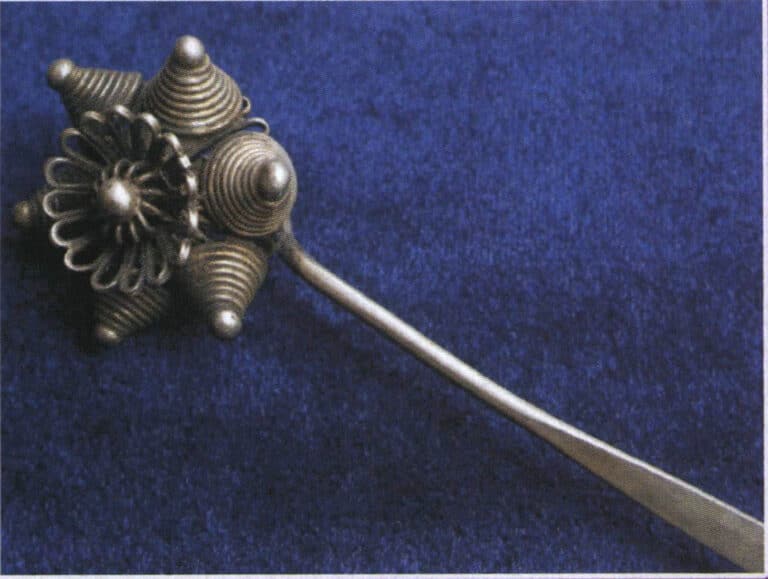
Miao silver hairpin

Miao silver crown with silver horns
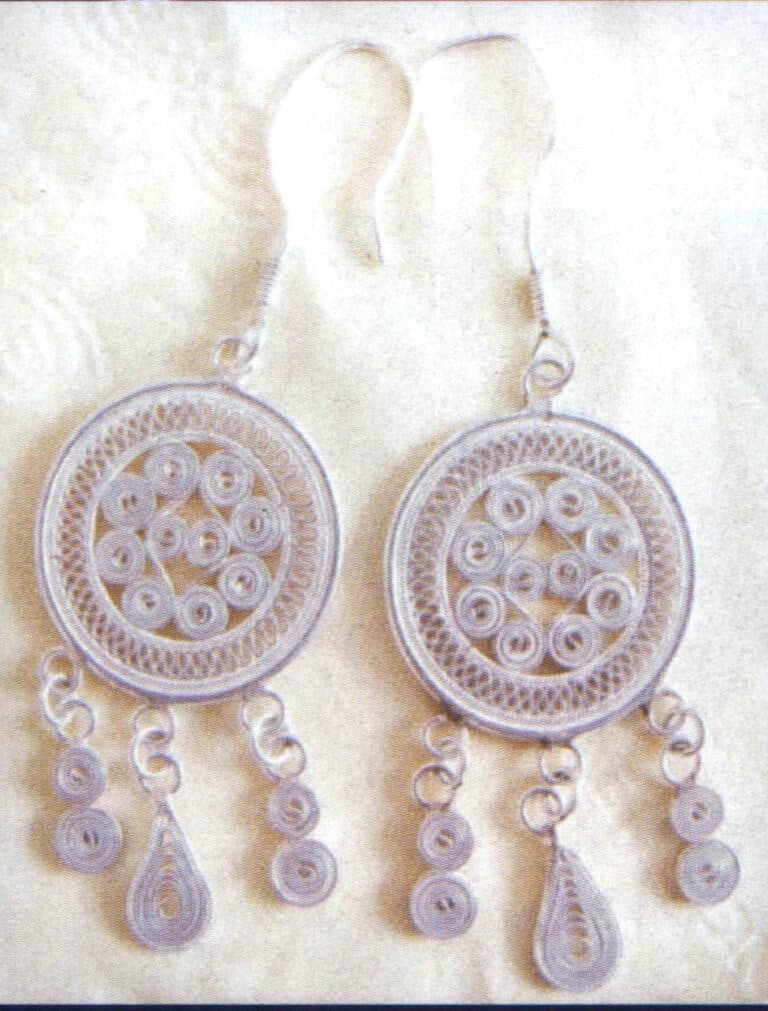
Miao silver earring
3.2 Neck Ornaments and Chest Ornaments
These two ornaments are found in almost every branch of the central and eastern dialect regions. The Miao people often adorn their necks with collars and necklaces. Both men and women wear them, but they are primarily for women.
(1) Collars. There are circular, flat, disc, spiral, horn, hexagonal, Nuss, hollow necklaces, etc. If there are multiple layers of collars, they are arranged in a circular shape in a set from small to large. The chain necklaces in places like Shidong are made up of dozens of interlocking round or oval solid silver rings, which are rugged and heavy. A type of louvered silver collar from the Jianhe River consists of three triangular maple leaf patterns arranged from small to large, with one circle covering another, concealing the wearer’s entire neck and chest.
(2) Chest Ornaments. There are collar clips, silver chains, silver locks, silver chest plates, silver pendants, etc. When paired with traditional Miao attire, Miao women’s neck and chest ornaments appear particularly extraordinary. The chest plate is called “collar clip” in Chinese and is a silver plate suspended in front of the chest. It is made from a piece of silver that is pressed into a patterned mold with intricate designs. Many silver chains are welded to the lower edge, with silver bells and trumpets attached to each chain’s ends. A thicker and longer silver chain is welded to the upper edge of the silver plate, which is worn around the neck.

Miao silver collar

Miao silver badge
3.3 Waist Ornaments
Mainly bracelets and rings.
(1) Bracelet. Mainly worn by women, but also worn by men. Some have a “life-saving bracelet” worn since childhood after a ceremony conducted by a shaman, which is extremely precious. Bracelets come in various shapes, including cylindrical, round beads, knots, dragon heads, silkworms, spirals, long tubes, etc., in various styles. In terms of manufacturing methods, there are silver wire woven bracelets, hollow flower bracelets, silver sheet bracelets, etc. The silver wire woven bracelet is made by twisting three or four fine silver wires together, totaling several strands, which are then woven into a hexagonal bracelet, with a pattern resembling the character “人” stacked positively and negatively, hollow inside. The hollow flower bracelet is made of fine silver threads crafted into small petals, which are welded together to form a cluster of flowers. Then, several clusters are welded together to create a flower bunch. Additionally, a small flask the size of a finger is made from thin silver sheets, with a small silver bead welded to the outer bottom of the flask resembling a nipple. Four silver pins are shaped into a bracelet, and then the flower bunch and silver flask are placed over the silver pins and welded together to form the bracelet. The silver sheet bracelet is made from a piece of silver sheet, approximately three inches wide, in a long cylindrical shape, with exquisite patterns resembling the wrist guards of ancient warriors.
(2) Rings. They are considered beautiful when wide and can be worn in formal and casual attire. Generally, people prefer to wear multiple rings. In the Miao ethnic group near Guiyang, both hands wear eight rings, with only the thumbs not adorned.
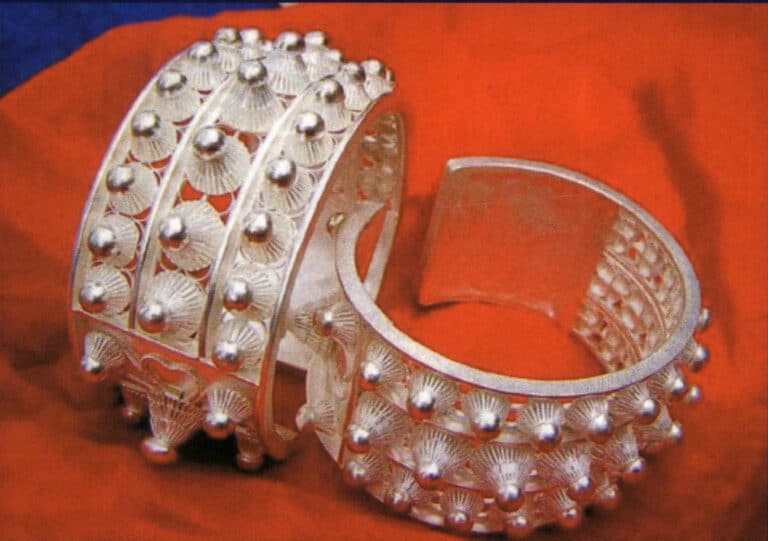
Miao silver hollow flower bracelet
3.4 Clothing and Accessories
The clothing accessories mainly include silver clothing pieces, beads, waist chains, buckles, etc.
(1) Silver clothing pieces. They are a unique decoration of the Miao ethnic group in southeastern Guizhou, draped all over the body, resembling a warrior’s armor. In some places, the clothing is even decorated with hundreds of silver bodhisattvas and dozens of silver beads, with bells attached, and a single outfit is almost completely adorned. The lower edges of the clothing and the hems are also equipped with silver pendants and beads, with small butterfly silver pieces with silver pendants sewn onto the cuffs. When worn, they create a striking effect. The silver clothing pieces are usually stacked in a box, and when it’s time to wear them for festivals, they must be painstakingly pinned and unpinned each time to protect the elaborate outfit from being damaged by the silver pieces.
(2) Silver beads. They are the main decorative pieces of silver clothing, varying in size. Large silver beads are made by pressing round silver discs the size of a cup, mouthing them into molds with patterns like coiling dragons, with clear patterns that are hollowed out. Small silver beads are pressed into coin shapes, and the edges of both types are tapered with silver eyes, which are nailed onto the clothing. Silver bells are spherical, about the size of cherry pits, made from two thin silver sheets shaped into semicircles and then joined together, with a small iron sand inside. An opening is at the bottom of the bell, and a small silver chain is welded on. Silver bells can be attached individually to clothing or used as accessories for other large silver ornaments.
(3) Waist chain and silver buckle. They are accessories for the waist and top, and the silver buckle is exquisitely crafted with practical value.

Miao silver clothing
4. The Miao Silver Production Process
4.1 Miao Silver Production Process
The processing of Miao silver jewelry is entirely completed through manual operations in family workshops. Wearing handmade silver products holds a significant place in the lives of Miao women. The craftsmanship of Miao silver jewelry is very complex, with a single piece of silver jewelry often requiring twenty or more processes to complete. The silversmith first melts the silver to create thin sheets, silver bars, or silver wires and then uses techniques such as hammering, striking, pressing, cutting, engraving, carving, twisting, polishing, sculpting, and welding to create exquisite patterns, which are then welded or woven into shape.
(1) Producing silver profiles. First, melt the scrap silver and shape it into strips, sheets, wires, and other profiles as needed. Most workshops have specialized charcoal furnaces with strong firepower, and since they use bellows to supply oxygen, the silver material in the crucible melts quickly. It is then poured into stone troughs to be cast into strips, cooled, and further processed; And go side of the craftsmen in the melting of silver, the first broken silver in a small crucible, and then put a small amount of borax powder on the shelf, under an oil lamp, the craftsmen will be lit, holding a copper blowpipe, blowing the fire until the crucible in the silver melted into liquid. The silver liquid is poured into an iron trough, and after a while, it solidifies into silver bars. Once the silver bars have completely cooled, they can be clamped with pliers and hammered into sheets or drawn into strips for use (Figure 3-1).
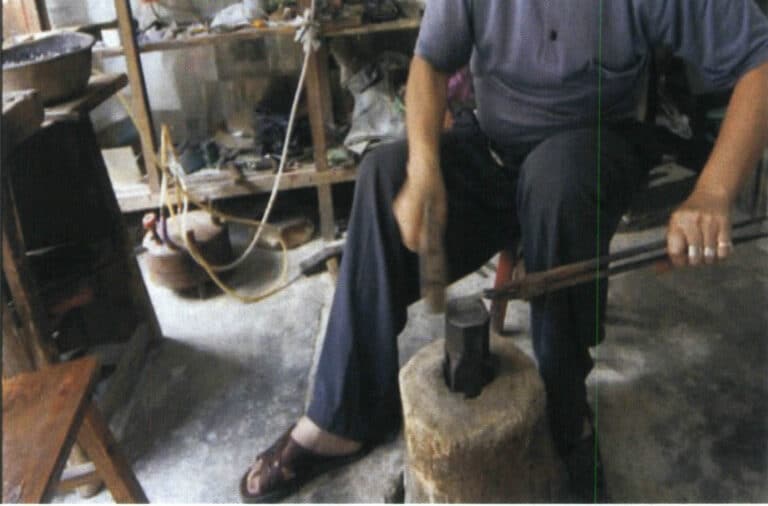
Figure 3-1 Forging Silver Plate
(2) Processing of spare parts. When the silver pieces or silver bars are prepared in sufficient quantity, the craftsman can further process the silver pieces and silver bars according to the patterns required by the customer, shaping them into the basic form of silver jewelry components. One method is to paint the pattern draft on the silver piece with ink, then use chisels of different shapes to carve out the patterns, or place the silver piece or silver bar in an iron mold and directly hammer it to create raised and recessed patterns (Figure 3-2). The patterns created in this way are slightly coarse. Another method is to place the silver piece in a tin male-female mold to hammer out the raised and recessed surfaces, then attach the silver mold piece to a wooden board with rosin and use chisels of various sizes to strike according to the texture of the pattern, which can produce more refined silver pieces.
Silver wire is usually made from thin silver strips, which are fine and uniform, and some are forged with various shapes for special purposes. Single strands are often used as edge lines, while multiple strands are twisted into a braided shape. The required accessories are woven from silver wire, and then each accessory is gradually assembled (Figure 3-3), followed by welding. The accessories are soaked in boric acid water and then arranged according to the style required for each part of the jewelry on fireproof bricks. Welding flux is sprinkled on the welding area, a spray gun is ignited, and the flame is directed to the welding area for welding (Figure 3-4).
(3) Molding and production. After all the components are processed, they are woven into the desired shape and fixed at the joints by welding, resulting in the overall shape of the silver jewelry.
(4) Decoration. Use a file to trim the workpiece. If it is necessary to do kingfisher feather decoration or enamel firing to the silver ornament, it is achieved by sprinkling the glaze powder on the area to be colored and then firing it, which is also done by blowing fire with a blowpipe. The uniformity and beauty of the color are entirely mastered by the craftsman based on experience, and it is also one of the standards for assessing the craftsman’s technical level. The entire piece of jewelry is boiled in alum water to whiten it, then polished with a cloth until it shines, and finally, the entire piece is shaped (Figure 3-5).

Figure 3-2 Hammering Pattern
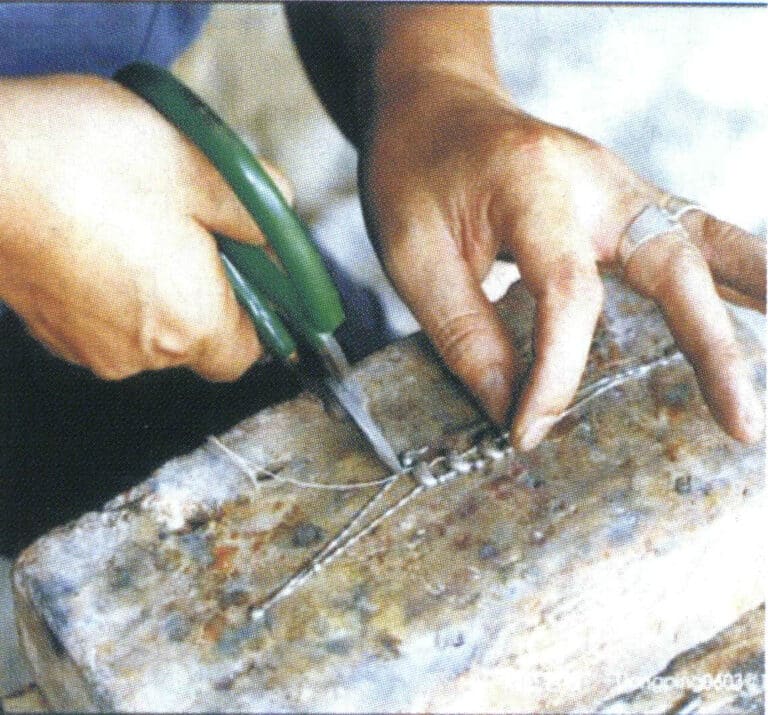
Figure 3-3 Accessory Combination
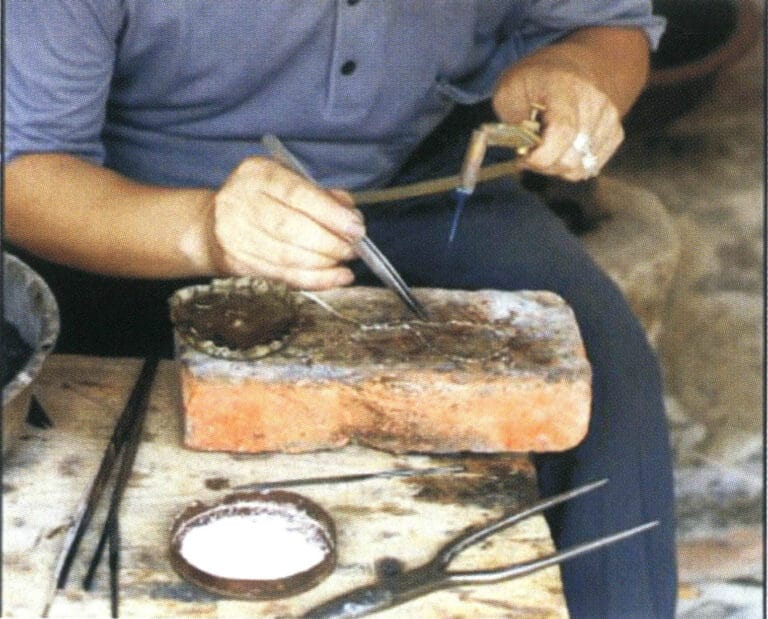
Figure 3-4 Accessory Welding
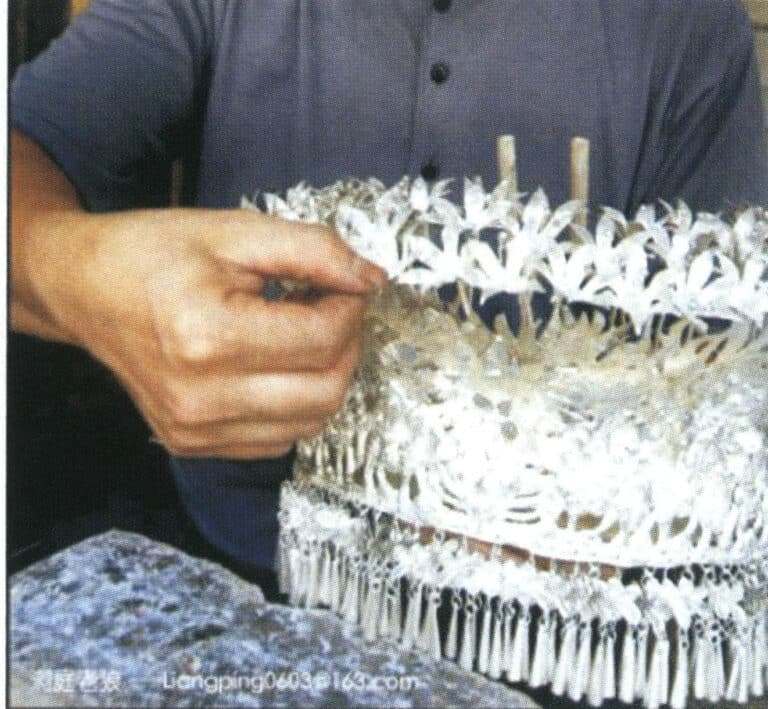
Figure 3-5 Jewelry Calibration
4.2 Characteristics of Miao Silver Production
Due to the high demand for silver jewelry, the Miao silver craftsmanship is extremely prosperous and developed. For example, Guizhou has hundreds of family-run silver workshops within Guizhou, and the number of people engaged in silver jewelry processing is as high as several thousand. Miao silver craftsmen generally inherit their trade from their fathers, passing it down through generations, and their skills are rarely shared outside the family. Silver workshops are divided into fixed-point and itinerant, with fixed-point being the majority. They process silver jewelry at home; itinerant silver craftsmen also operate as family workshops, often closing during busy farming seasons and going out to seek business during the off-season.
The processing of silver jewelry is entirely completed through manual operations in family workshops, and the production process is relatively complex. The shape of silver jewelry itself requires extremely high manual skills from the silversmith, making it difficult for anyone who is not a master in the field to accomplish. The silver jewelry produced through this craft is simple and natural, full of nostalgic charm, unlike those produced on mechanized assembly lines with the same molds. The finished accessories may appear slightly rough, but they are full of spirit, and the small handmade imperfections on the accessories make them even more charming.
Miao silverware not only excels in craftsmanship but also stands out in design. The reasons for this are twofold: first, Miao silversmiths are adept at drawing creative inspiration from women’s embroidery and batik patterns; second, there are many branches within the Miao ethnic group, and to gain a competitive edge among peers, Miao silversmiths innovate in detail and local depiction based on their branch’s traditional customs and aesthetic preferences, striving for excellence in craftsmanship, which makes Miao silver ornaments increasingly perfect. Of course, all of this must be based on not altering the silver ornaments’ overall shape. Miao silver ornaments have a certain stability in their design; once ancestors establish a shape, it cannot be changed, often becoming an important branch symbol.
Section II Tibetan jewelry and Production Techniques
1. Introduction to Tibetan Decorative Accessories
The concept of jewelry in Han culture is generally seen as an “embellishment” for the body and clothing, while in Tibetan culture, especially for women, the phrase “fully adorned” is more fitting. In this region where Buddhism is prevalent, jewelry has become more than just a simple decoration; it has become a part of the daily life of the Tibetan people. Whether in daily life, during festivals, or while on pilgrimages, people are “fully adorned” with various jewelry. On their heads, they wear Bazhu, hairpins, hair clips, bone rings, and jade discs; silver coins in their braids; various earrings; necklaces, bead jewelry, and protective amulets like ancient metal relics and gaus around their necks; patterned belts, metal belts, hanging fire striker boxes, waist bags, milk hooks, Tibetan knives, waist buckles, snuff bottles, seashells, small bells, and a large array of exquisite jewelry around their waists; various rings and bracelets on their hands; and colorful decorative ribbons and various gold and silver jewelry draped over their backs.
Copywrite @ Sobling.Jewelry - Κατασκευαστής προσαρμοσμένων κοσμημάτων, εργοστάσιο κοσμημάτων OEM και ODM
2. Types of Decorative Materials and Accessories Jewelry
People love Tibetan Jewelry for their simplicity, ruggedness, and mystery. The materials used for Tibetan Jewelry are diverse, including cow bone, pure silver, Tibetan silver, tricolor copper, agate, turquoise, beeswax, coral, shell, and Dzi beads, all the main raw materials for making Tibetan ornaments. Here, we will briefly introduce Tibetan silver, tricolor copper, cow bone, and Dzi beads. Other materials are detailed in specialized gem identification, so they will not be elaborated here.
2.1 Tibetan Silver
Traditionally, Tibetan silver is made by adding 70% copper to 30% silver, often using a small amount of silver mixed into cupronickel, creating a silver-like ornament. This type of ornament has a texture very similar to silver but is more wear-resistant than pure silver. Due to the material’s certain ductility, it can often be crafted into exquisite filigree products. Traditional Tibetan silver, with silver added to cupronickel, can be bent without breaking easily, and when thrown on the ground, it produces a loud sound with penetrating power. But now Tibetan silver has become a term; with the popularity of Tibetan jewelry, more and more people will buy low-cost tin and aluminum alloy products called Tibetan silver. This jewelry is not easy to bend and easy to break, either dull in color or surface roughness, either white or light. Thrown on the ground, it sounds dull. The other is the widespread use of completely cupronickel instead.
Among the many accessories, silver jewelry is particularly favored by young people. Its cold and glamorous shine and smooth lines resemble a youthful and fashionable dream. In today’s popular folk culture, Tibetan silver jewelry attracts many people’s attention with its profound cultural connotation and rugged style. The mystery and uniqueness derived from Tibetan culture make almost every piece of Tibetan silver jewelry a unique regional landscape painting. Tibetan silver jewelry is distinctly different from silver jewelry in other regions, not only in Tibetan inscriptions but also in the silver itself. Tibetan silver is divided into old silver and new silver. As the name suggests, old silver is like old jade; the longer it lasts, the more valuable it becomes. Therefore, it may appear a bit dirty, but this type of silver is already hard to find in Tibet.
There are many types of Tibetan silver jewelry; the typical ones are as follows.
(1) Tibetan silver bracelet. There are several typical styles of Tibetan silver bracelets, among which two are the most common: plain metal bracelets engraved with patterns or Sanskrit bracelets such as the Ten Symbols of Freedom Sanskrit bracelet. The Ten Symbols of Freedom is the essence of the Wheel of Time, composed of seven Sanskrit letters and three shapes, symbolizing the unity of the main deity of the secret mantra and its mandala in a Wheel of Time diagram. The other interpretation refers to the rights mentioned in Buddhist scriptures, which include “freedom of life, freedom of mind, freedom of resources, freedom of karma, freedom of understanding, freedom of rebirth, freedom of will, freedom of supernatural powers, freedom of wisdom, and freedom of dharma.” For example, bracelets with Tibetan characteristic patterns are both ancient and carry a hint of mystery.
Another type is the inlaid bracelet, primarily in red, blue, yellow, etc., with the most common agate, turquoise, or amber. Tibetan people have cherished rare stones since ancient times, believing that the rarer the stone, the more religious significance it holds. Almost every Tibetan likes to wear agate, coral, turquoise, amber, and other stones as amulets on their chests to ward off evil spirits and demons. The Tibetan preference for turquoise and its widespread use is not only due to its brilliance but is also said to be because turquoise is considered an embodiment of the divine, a symbol of power and status, and the most popular sacred ornament, used in the crown of the first Tibetan king and as offerings on altars. Tibetans love to wear red agate, coral, and amber, closely related to Buddhism. Tibetan Buddhism regards red coral and amber as embodiments of the Buddha, using coral as a lucky charm for worship, often made into prayer beads or used to decorate statues of deities, making them highly valued jewelry gemstones.
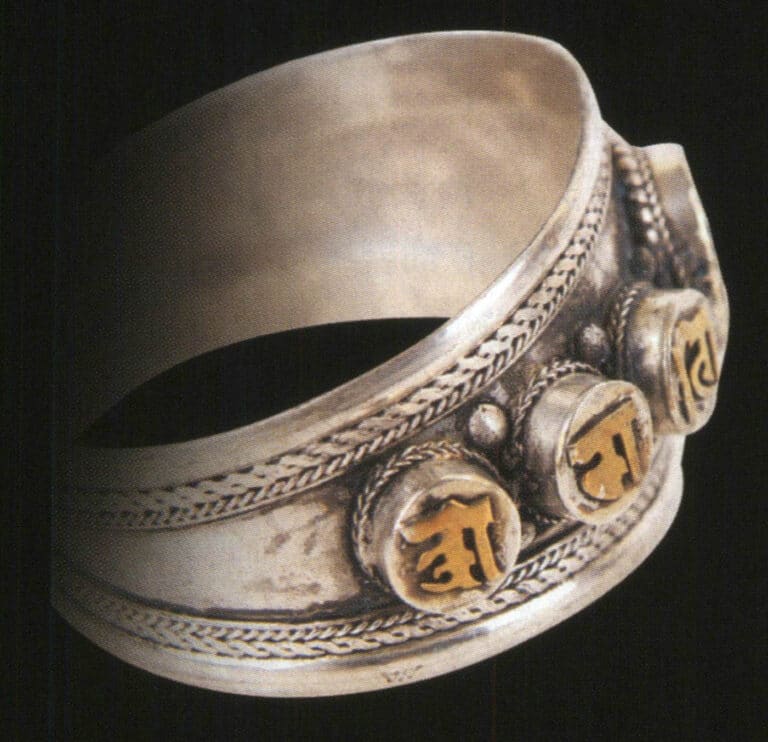
Ten Symbols of Freedom Sanskrit Tibetan Silver Bracelet

Engraved Tibetan Silver Bracelet
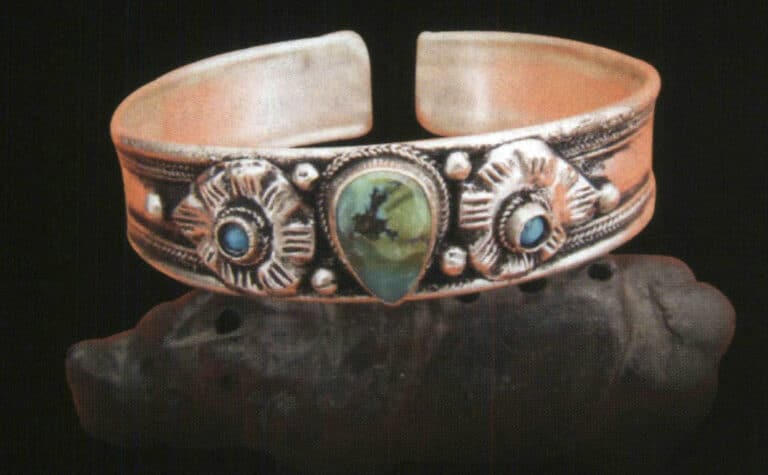
Tibetan Silver Bracelet with Turquoise
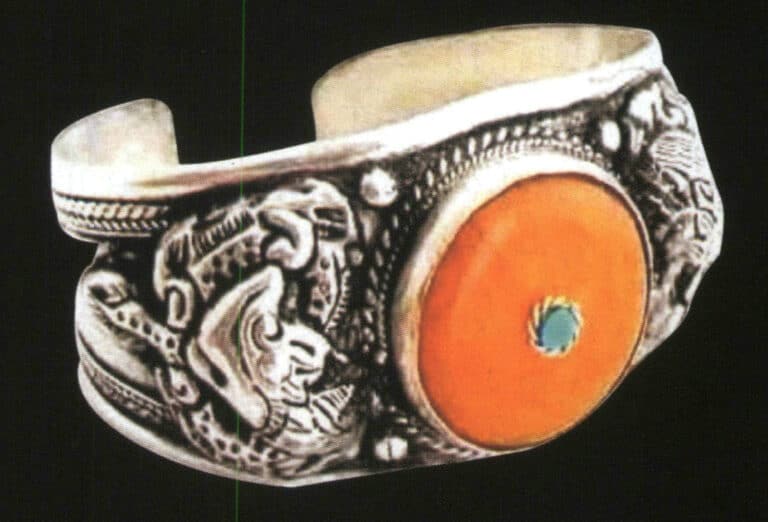
Beeswax Tibetan Silver Bangle
(2) Tibetan silver bracelet. A typical Tibetan silver bracelet comprises Tibetan silver accessories composed of turquoise, coral, agate, and other materials. Tibetan amulets deeply connect with Tibetan Buddhism and contain mysterious patterns with Buddhist mantras. Several types include the six-syllable mantra, gawk, ritual implements, thunder stones, and gemstones. In traditional Tibetan views, the protective function of amulets is valued more than their decorative value. They believe that the places where amulets are worn are key body parts, and wearing an amulet can prevent evil from entering.
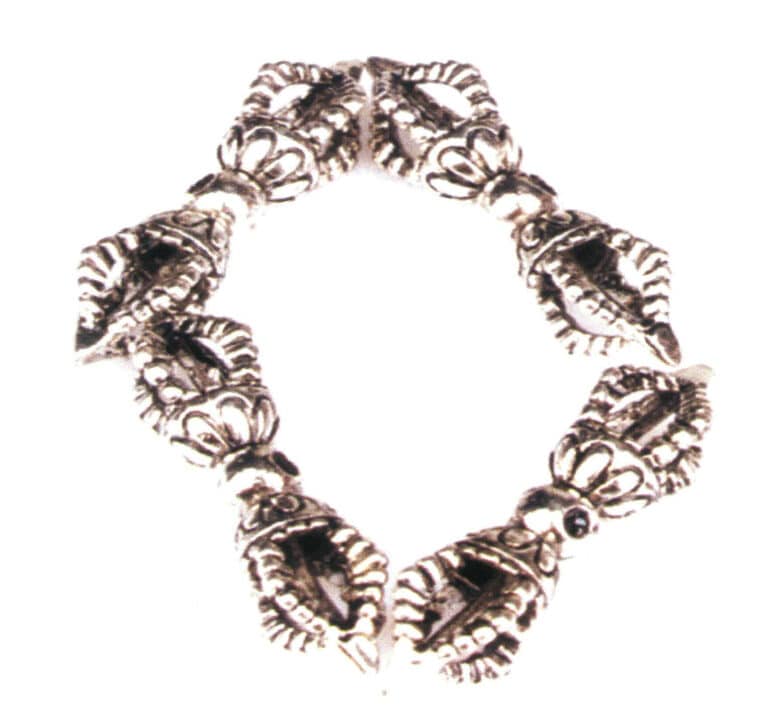
Tibetan Silver Amulet Bracelet

Tibetan Silver Turquoise Bracelet
(3) Tibetan silver rings. Tibetan silver rings can be divided into open and closed types. Similar to Tibetan silver bracelets, plain metal Tibetan silver rings often feature patterns or decorations with regional characteristics. In contrast, inlaid rings are often set with turquoise, agate, and coral gemstones.
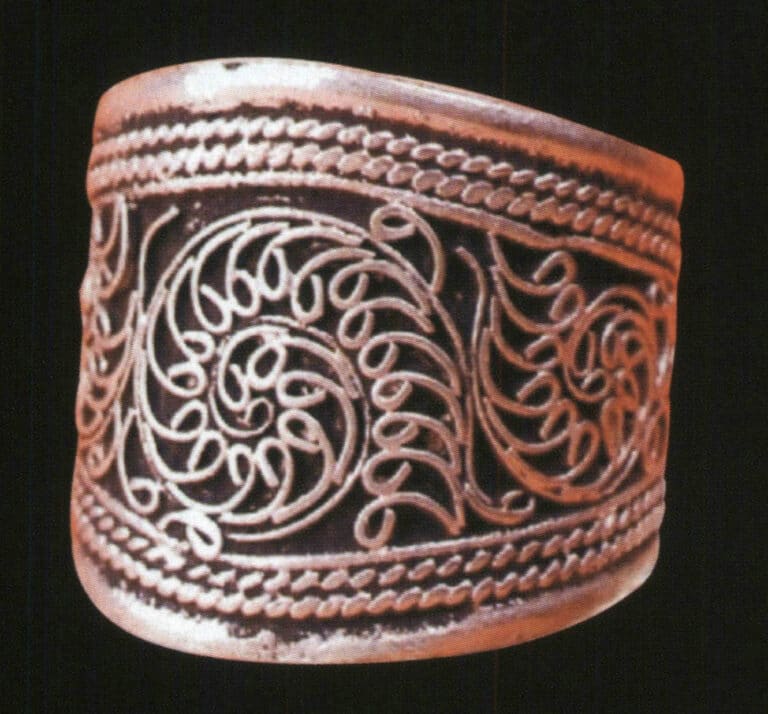
Tibetan Silver Ring

Turquoise Tibetan Silver Ring
(4) Tibetan silver necklaces, Tibetan silver earrings, and Tibetan silver pendants are also typical Tibetan silver accessories.
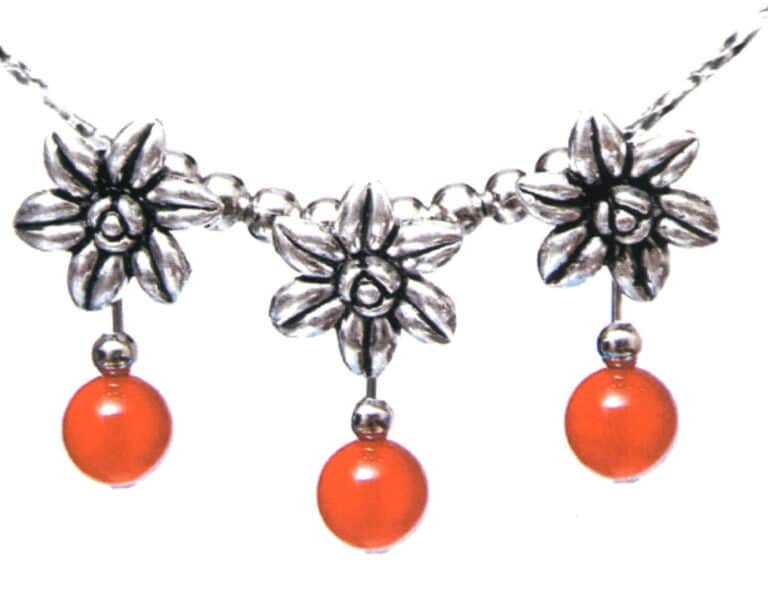
Tibetan Silver Necklace with Agate

Turquoise Tibetan Silver Necklace

Tibetan Silver Earrings

Turquoise Tibetan Silver Earrings
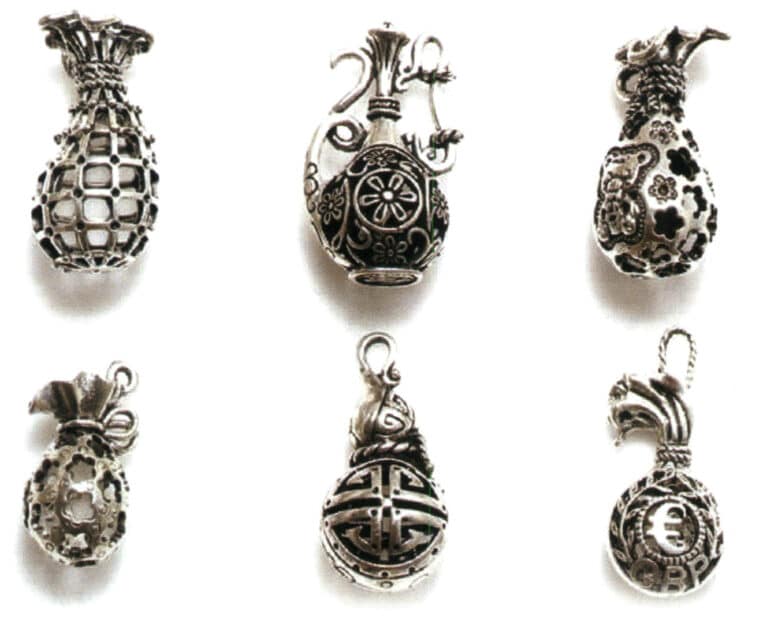
Tibetan Silver Pendant

Tibetan Silver Pendant
2.2 Tricolor Copper
Tricolor copper refers to the carefully crafted copper made from three colors: white, yellow, and red. Tricolor copper bracelets and rings are distinctive Tibetan Jewelry that are very popular among the Tibetan people.
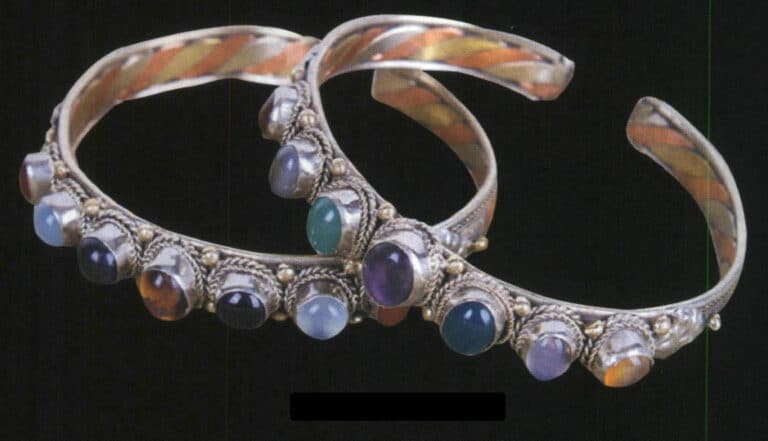
Tri-color copper inlay bracelet
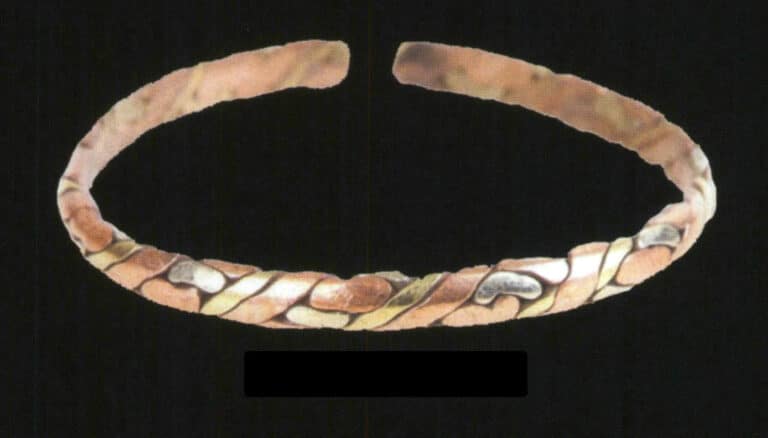
Plain tri-color copper woven bracelet

Tricolor copper ring
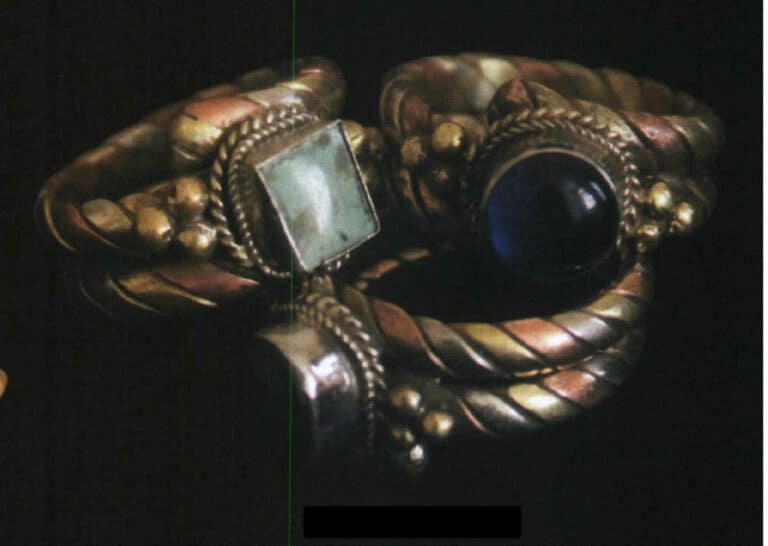
Tricolor copper inlay ring
2.3 Ox Bone
Tibet is a land full of magical colors, where all things absorb spiritual energy. The yak is the best friend of the Tibetan people and is regarded as a beautiful and sacred animal. Unique decorations carved from pure natural materials such as yak bones and yak horns are primitive and rugged, symbolizing the warding off evil and bringing good fortune while adding a wild charm to the wearer. Many types of yak bone Tibetan Jewelry, commonly including pendants, rings, bracelets, necklaces, and earrings.

Plain ox bone pendant
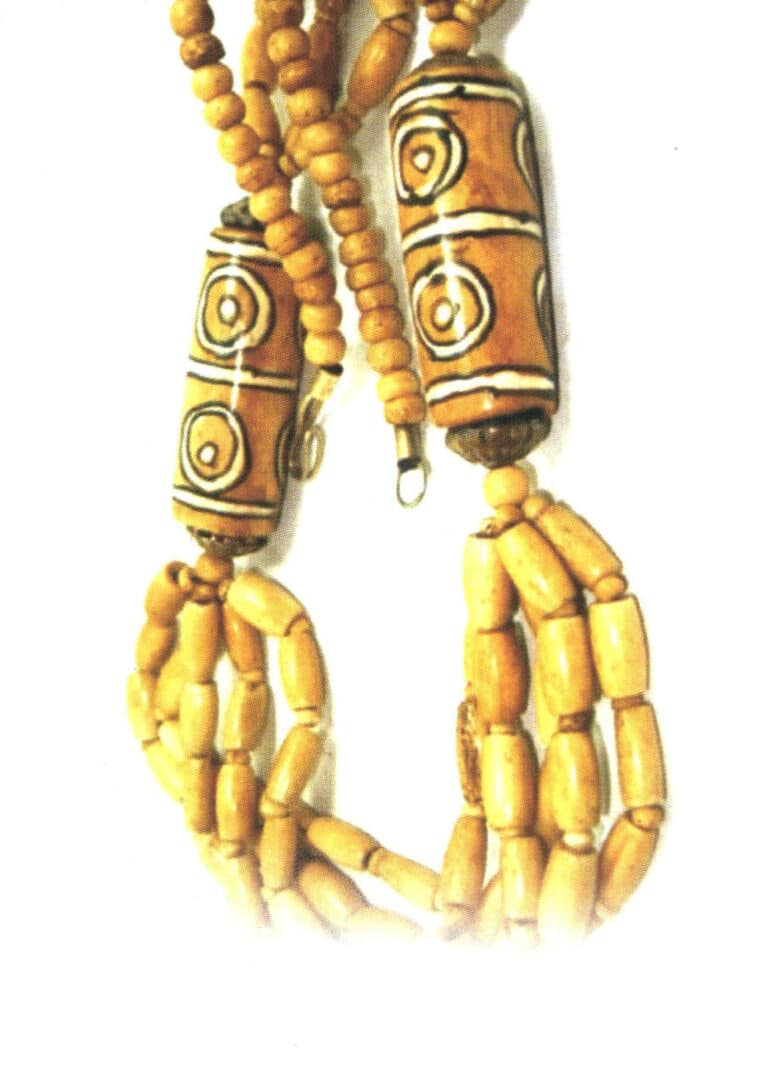
Ox bone necklace

Inlaid ox bone pendant
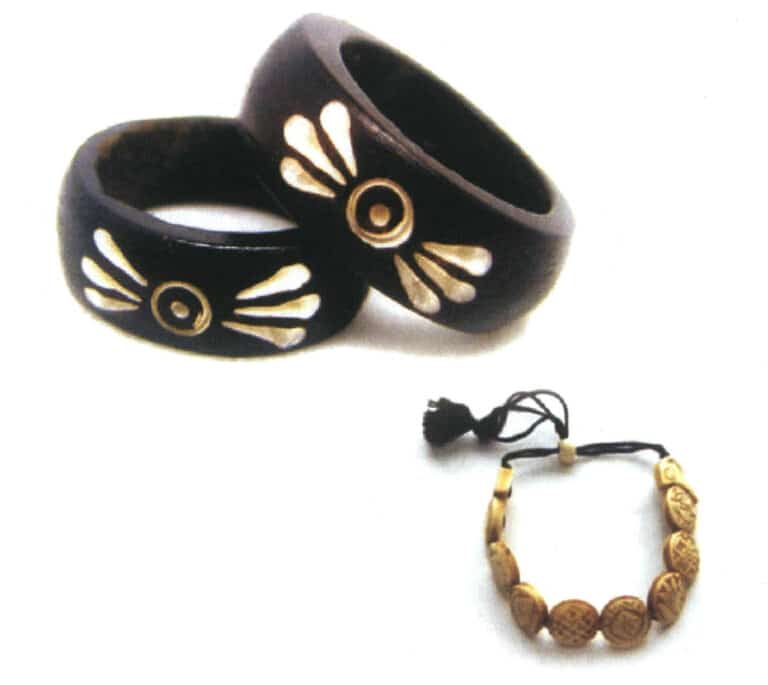
Ox bone ring
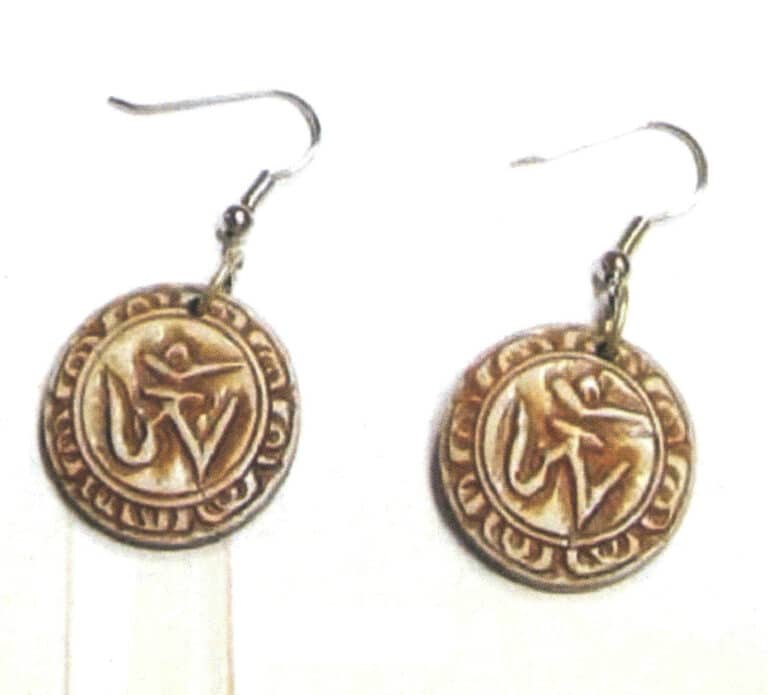
Ox bone earrings

Ox bone bracelet
2.4 Dzi Bead
The main production areas of Dzi beads are Tibet, Bhutan, Sikkim, and Ladakh, which are in the Himalayan region. It is a rare gemstone, and Tibetans still believe that Dzi beads are “heavenly stones.” It is said that the history of “heavenly eye beads” can be traced back 5,000 years, when Tibetans discovered that this mine had a powerful magnetic field, leading them to mine it and grind it into shapes like pestles and round plates. Due to the underdeveloped engineering technology at that time, they could only obtain light-colored, grayish-white, shallow ore without obvious patterns. Therefore, Tibetans painted various auspicious patterns on them (such as treasure vases, lotus flowers, tiger stripes, eye patterns, lines, etc.). After high-temperature treatment, the pigments would penetrate deep into the ore. If further blessed by great practitioners, they could possess incredible magical powers.
Dzi beads are nine-eyed stone shale containing jade and agate components and are one of the seven treasures of Tibetan Buddhism, recorded in historical texts as “nine-eyed stone Dzi beads.” The internal structure of heavenly beads has a strong natural cosmic magnetic field energy, with the “ytterbium” element having a particularly strong magnetic field. Only Tibetan Dzi beads possess this special element, so only agate from Tibet is called Dzi beads. In contrast, agate from Brazil, Persia, Russia, Indonesia, and Taiwan cannot be called Dzi beads. Due to the high magnetic field energy, heavenly beads are regarded as sacred objects with the effects of warding off evil, treating blood disorders, preventing strokes, and enhancing internal energy.
The colors of Dzi beads can be roughly divided into black, white, red, coffee, and green, while the color of shale varies depending on the chemical substances it contains. For example, those containing iron oxide appear red, those containing iron hydroxide appear light yellow, and those containing carbon appear gray-black. Dzi beads are made from natural stone artificially ground and painted with patterns before being fired into shape. It is said that each pattern has its meaning, and based on the number of eyes on the surface of the Dzi bead, they can be classified into different grades. The more eyes (or “mou” numbers) there are, the more precious they are, and different numbers of eyes represent different meanings.
The categories of Dzi beads jewelry are also diverse, commonly including bracelets, necklaces, and pendants, and they are also used to make rings, bangles, earrings, or inlay purposes.

Dzi bead bracelet
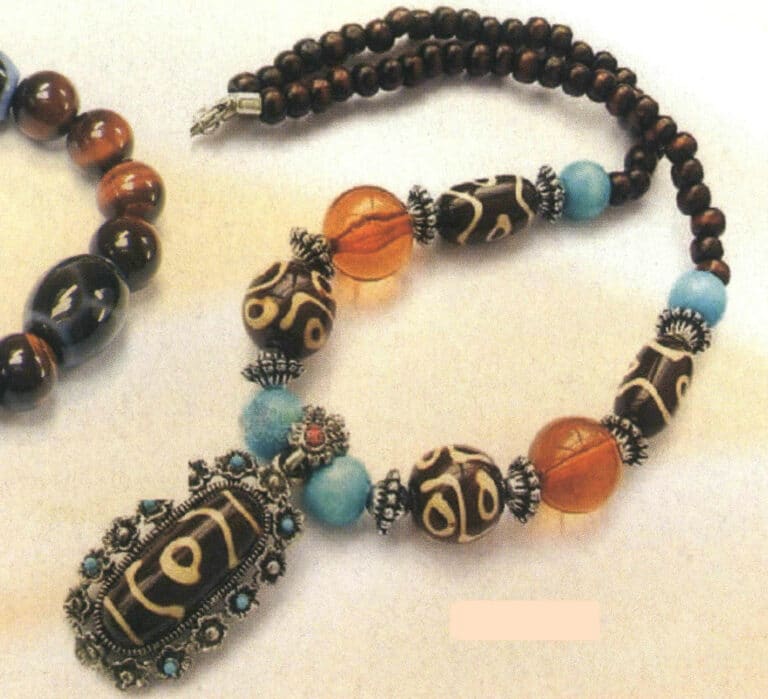
Dzi necklace
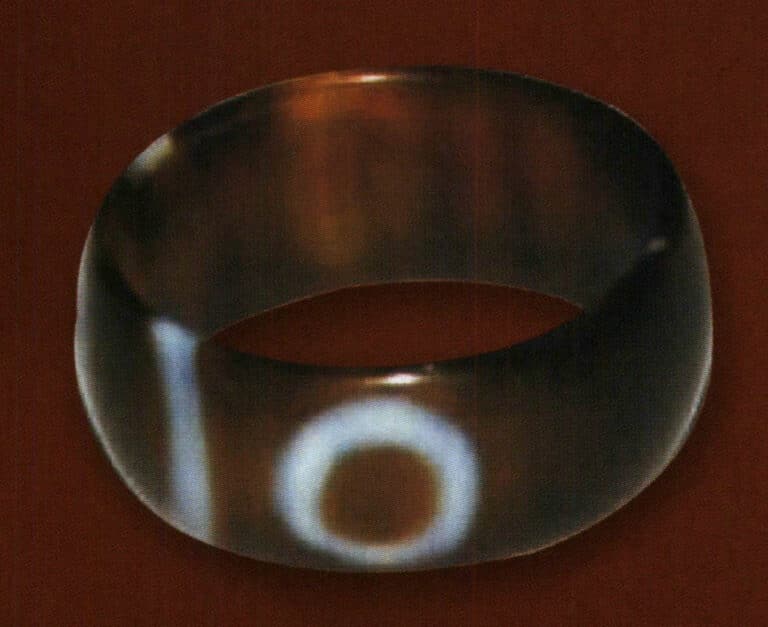
Dzi bead ring

Tibetan silver Dzi bead ring

Dzi earrings

Dzi pendant
3. The Craftsmanship of Making Tibetan Jewelry
(1) Tibetan Silver, Tricolor Copper Jewelry
Tibetan silver and tricolor copper Jewelry are mostly handmade, using various techniques such as melting, welding, forging, engraving, carving, and filigree. The Jewelry are generally treated to look aged. Tibetan decorations have unique characteristics in the selection of materials and production of gold and silver jewelry, with distinctive features in the processing and engraving of gold and silver.
(2) Ox Bone Accessories
Many use materials such as yak bones and teeth, which are made through multiple processes, including grinding, polishing, bezel setting, carving, aging, and moisture-proofing. The carving technique follows ancient folk traditional craftsmanship, combining ethnic style and Tibetan culture to create unique, high-quality products.
(3) Dzi Bead Accessories
Natural Dzi beads are rare and precious, and the production method is consistent with other gemstones, mainly relying on cutting and polishing.
Most of the Dzi beads circulating in the market today are artificially made. First, the raw materials are ground into the shape of Jewelry; then, the surface patterns are processed. The patterns are painted with lead-containing paint and fired at high temperatures. Different patterns have different meanings. The materials for Dzi beads are selected from nine-eyed shale, and there are also those made from chalcedony and agate, as well as those made from glass beads and plastic beads. Additionally, many agate beads in the market, regardless of whether they come from the original Tibetan source, are all claimed to be “Tibetan Dzi beads.” Those that have been worshipped for many years are called old Dzi beads, while the others are called new ones. There are also terms like type one and type two. Early fake Dzi beads were made from porcelain, while current materials include glass, agate, and plastic. Many Dzi bead dealers in Taiwan prefer to use agate from Liaoning Province because this sedimentary rock, when cut into a spherical shape, shows concentric circles in the cross-section, which the dealers refer to as “eyes.” The surface patterns are processed using chemical solvents or laser technology.
4. The Characteristics of Tibetan Jewelry
More people increasingly love various Jewelry that permeate the essence of Tibetan culture as they embrace individuality. Tibetan Jewelry are all handmade, and their themes usually reflect religious myths, scenes of labor and life, and the creators’ wishes and beautiful fantasies. Tibetans place great importance on the artistry and cultural significance of decorative Jewelry, and they are adept at transforming animals, plants, and idealized auspicious symbols from life into patterns that appear in jewelry. With the development of society, some patterns have become identifiers for various social classes and professions. More prominently, the strong influence of religious culture on patterns and the religious concepts attributed to jewelry pendants by Tibetans is evident. For example, religious cultural symbols such as “Three Jewels of Flame,” “Ten Powers of Freedom,” “Two Deer,” “Garuda,” “Water Dragon,” and many other religious symbols are adopted and applied in various forms. Each Jewelry has a unique cultural connotation and expresses a sincere blessing, making them especially suitable for gifting to friends and family or home decoration.
In summary, Tibetan Jewelry have the following prominent characteristics.
(1) Mysterious. Most Tibetan Jewelry contain rich religious connotations, many of which have directly evolved from the ritual implements of Tibetan Buddhism. It is filled with the mysterious colors of Tibetan Buddhism, much like the Tibetan Plateau.
(2) Unique. The materials used to make Tibetan Jewelry are diverse and colorful, including Tibetan silver, tricolor copper, beeswax, coral, turquoise, cow bone, and Dzi beads, all commonly used Tibetan Jewelry materials.
(3) Beautiful. Under the fashionable design, it also contains an antique style. It has a unique artistic charm and appeal that any other ethnic characteristic Jewelry cannot replace.
(4) Old-fashioned. Most Tibetan Jewelry are handmade, and Tibetans emphasize applying oil to their bodies, representing health. Lamas do the same, so some Tibetan Jewelry have dirt circles, giving them an ancient feel.Jewelry
Section III Thai Silver Jewelry and Production Techniques
1. Thai Silver
Thai silver originated in Thailand, usually called Thai silver, also known as “black silver.” Thai silver is made using the property of silver turning black when it comes into contact with sulfur. This creates a striking contrast with the shiny silver-white of sterling silver, resulting in a unique visual effect. After undergoing special anti-tarnish treatment, Thai silver jewelry remains unchanged in color for a long time and has a surface hardness that is greatly enhanced compared to ordinary silver. Thai silver is a vintage retro craft, and its unique texture and color give this type of jewelry a sense of ruggedness and antiquity.
The silver content of Thai silver has several types, including 92.5%, 99%, 99.9%, with purity of 92.5% being the most common. However, many counterfeit Thai silver Jewelry are on the market, and some alloy Jewelry are treated to look old, deceiving consumers into thinking they are Thai silver.
The gemstones inlaid with Thai and Tibetan silver differ from Nepalese silver. Thai silver mainly features sparkling marcasite and garnet, with red and black being the main color tones of the gemstones inlaid Thai silver, which can shine beautifully in the sunlight. Marcasite, or tungsten steel, is Thai silver’s most common synthetic stone, usually cut octagonal. It has a unique luster that never fades and is easy to match, often inlaid in various types of jewelry, giving a strong decorative feel.
2. The Antiquing Process of Thai Silver

Ταϊλανδέζικο ασημένιο μενταγιόν
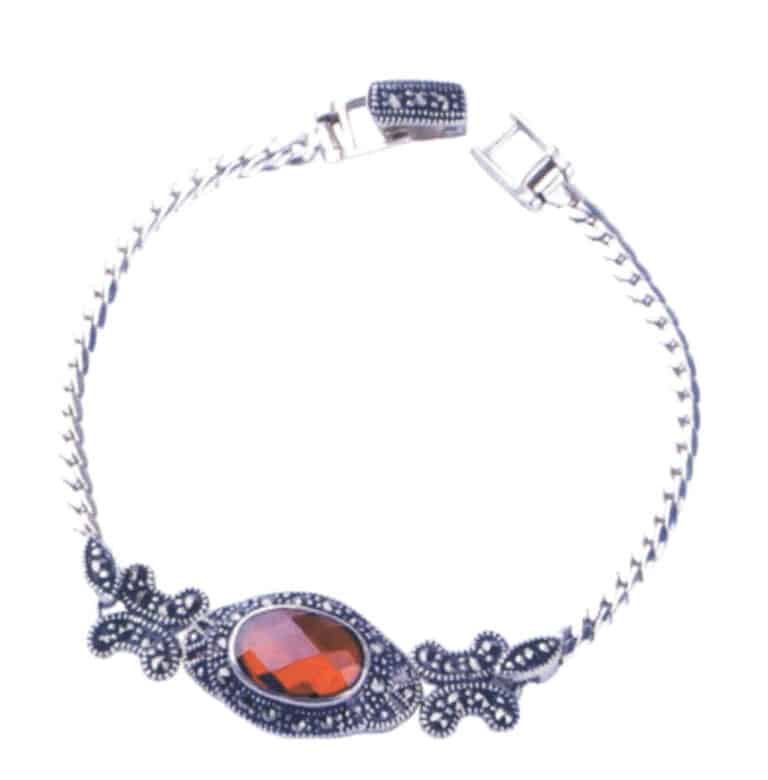
Thai silver bracelet
Various commercial silver blackening agents have appeared on the market, specially developed for antiquing silver alloy and silver-plated items. Adjusting and controlling the concentration of the dye and the dyeing time features convenience, speed, and low consumption. After dyeing and drying, depending on the size and shape of the jewelry, different methods, such as rubbing, grinding, sanding, or rolling, can be chosen for finishing. Finally, immerse, spray transparent paint or wax to seal the surface, and a more ideal antiqued silver luster can be obtained. The processing workflow generally includes jewelry degreasing → washing with water →dilute sulfuric acid activation → washing with water → silver blackening agent → washing with water → drying → polishing or buffing → sealing or painting → drying. The processing parameters depend on the composition of the blackening agent.
Before aging treatment, the oil stains on the surface of the silver jewelry must be completely removed; otherwise, it is impossible to achieve an even color. It is important to control the blackening time; if the time is too long, the coating will be too thick and may easily fall off (fade). If uneven color or mottling occurs during the blackening process, the pre-treatment can be strengthened or lightly wiped, and the blackening treatment can be reapplied. After blackening, gently wiping can enhance the decorative performance. Overall, the wear resistance of the blackening treatment layer is limited; to improve wear resistance, a thin layer of polyurethane varnish can be applied for protection.





